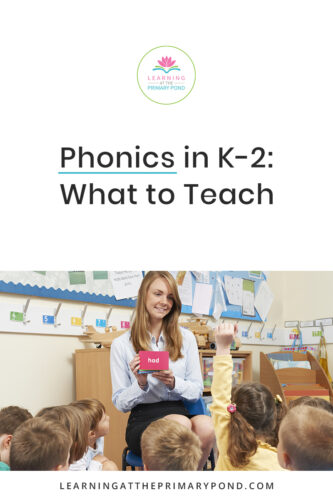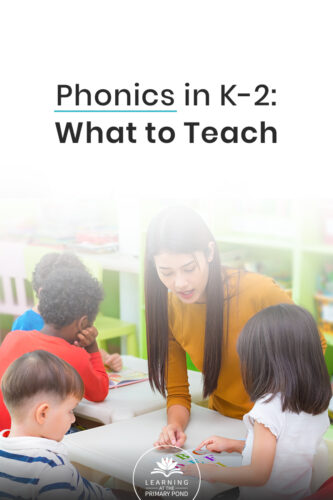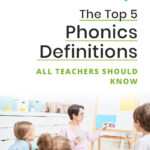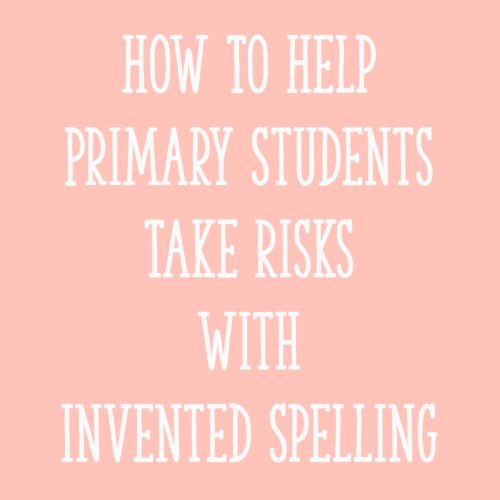Do you know what phonics concepts to teach in the primary grades?
A lot of teachers I’ve spoken with don’t have a guide. They don’t have a scope and sequence to use.
And that makes teaching phonics pretty tricky!! Because if you don’t know what to teach in phonics…then how could you possibly teach it? ?
In this post, I’ll explain what phonics concepts I teach in Kindergarten, first grade, and second grade – and we’ll also talk a bit about how to teach those concepts.
I also have a free phonics scope and sequence for you!

Your Scope and Sequence
A scope and sequence provides guidance in what to teach and when to teach it:
- The scope tells you what concepts and skills are covered
- The sequence tells you the order in which the concepts and skills are taught
Think of the scope and sequence as your road map for instruction.
Ideally, all the teachers at a school use the same scope and sequence. That way, the next teacher can pick up where the previous teacher left off.
If you’re looking for a phonics scope and sequence, you might be thinking, “Well, I want the BEST scope and sequence. I want to follow exactly what the research says!”
Honestly, a “perfect” scope and sequence probably doesn’t exist. But Bear and Invernizzi (see bibliography) have done some work to come up with a developmental scope and sequence.
This means that the scope and sequence follows students’ natural development in the phonics skills that they learn.
I have my own scope and sequence – which you can get for free – that incorporates some of their work, as well as my own experiences and my knowledge of the Orton-Gillingham method. So it’s a medley. ?
This free phonics scope and sequence comes from my phonics program, From Sounds to Spelling, available in September 2020.
(If you grab the free guide, don’t forget to finish reading the rest of this post. There’s more to the story!!)
Using Your Scope and Sequence Correctly
Systematic phonics instruction does not focus on the age of a child or the grade level of a group of students. The focus is on what a child already understands about phonics and what that child is ready to learn next.
When you open up my phonics scope and sequence, you will see grade levels listed. My level K (Kindergarten), and Levels 1 and 2 (First and Second Grade) scope and sequences cover what many students in these age groups need to learn.
But the magic is in YOU, their teacher! Your job is to figure out what they already know, so that you can then determine what they need to learn next.
And the way to figure this out is through assessment. The purpose of a phonics assessment is to figure out what students already know, and what’s appropriate for them to learn next.
If you sign up for a free trial of From Sounds to Spelling, you’ll find a quick assessment that you can use to figure out exactly what a student needs to work on. (Each grade level also contains a more detailed pre-test, once you’ve purchased Level K, 1, and/or 2.)
Phonics Instruction that Works
Here are two important practices to keep in mind when using my scope and sequence (or any scope and sequence):
- Use systematic, explicit instruction.
- Make concepts stick with distributed practice and review.
Systematic means you rely on the sequence outlined in the scope and sequence for the program, and follow that sequence with fidelity.
Explicit instruction uses clear language to make sure students know exactly what you want them to learn. (For example, explaining that “ch” is a digraph, and the two letters come together to make a new sound, /ch/.)
Distributed practice gives students many opportunities to practice what they’re learning. The practice sessions are short, and the sessions are distributed over a long period of time.
We want students to attain a baseline level of mastery (From Sounds to Spelling guides you in making sure that happens before you move on to the next skill). But then we come back to that concept repeatedly, to make sure that students retain it, even when they’re presented with new concepts to learn. From Sounds to Spelling includes intentional, built-in review.
If you’re interested in reading more about best practices for phonics instruction, you can read a longer post here.
I also have a FREE mini phonics audio course if you’d prefer to listen and learn! You can sign up for that here:
Phonics Audio Course Registration

Bibliography
Bear, D. R., Invernizzi, M., Templeton, S., & Johnston, F. (2015). Words Their Way: Word Study for Phonics, Vocabulary, and Spelling Instruction (6th ed.). Pearson.
Blevins, W. (2017). A Fresh Look at Phonics, Grades K-2. Thousand Oaks, CA: Corwin.
Mesmer, H. (2019) Letters Lessons and First Words. Portsmouth, MA: Heinemann.













Hi Alison,
Thank you so much for your post! Right before school closures, my school made a big push to incorporate more phonics instruction through methods such as your distributed practice. I agree that this was the right move, however, we were never given strategies and methods to incorporate more phonics through distributed practice. Do you have any suggestions or resources specifically for distributed practice? I’ve really enjoyed your blog and learning how to bring phonics to life through multisensory activities and exercises.
Hey there, Paige! I’m glad that you found these phonics tips useful! For distributed practice, I have a lot of different phonics activities in my From Sounds to Spelling Program (https://www.fromsoundstospelling.com/). I also have a digital phonics bundle on Teachers Pay Teachers (https://www.teacherspayteachers.com/Store/Learning-At-The-Primary-Pond-Alison/Category/-Digital-Phonics-Bundles-401515) that include activities that would work for remote, hybrid, and in-person learning. Both of those resources should be useful in providing your students with distributed practice! 🙂
Thank you for the great information. I love the chart to assist when to move on. I often struggle with this, I want to insure all students know the material, but also do not want to hold others back. Giving permission to change grouping is essential- students master skills at varying rates. I appreciate the download From Sound to Spelling.
Glad this was helpful, Paula! And yes, flexibility is key!